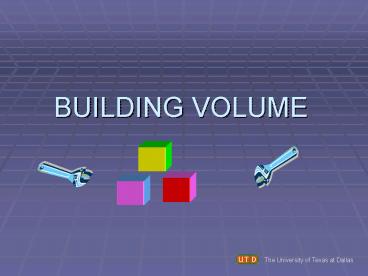BUILDING VOLUME PowerPoint PPT Presentation
1 / 32
Title: BUILDING VOLUME
1
BUILDING VOLUME
The University of Texas at Dallas
2
DESCRIPTION OF A CUBE
- WHAT IS A CUBE?
The University of Texas at Dallas
3
DESCRIPTION OF A CUBE
- A cube is a three-dimensional geometric figure
with all sides made of squares called faces. - How many faces does a cube have?
The University of Texas at Dallas
4
DESCRIPTION OF A CUBE
- IT HAS 6 FACES.
5
2
4
3
1
6
The University of Texas at Dallas
5
DESCRIPTION OF A CUBE
- Two faces intersect in a segment called an edge.
- How many edges does a cube have?
The University of Texas at Dallas
6
DESCRIPTION OF A CUBE
- IT HAS 12 EDGES.
width
height
length
The University of Texas at Dallas
7
DESCRIPTION OF A CUBE
- Three faces intersect in a point called a vertex.
- How many vertices does a cube have?
The University of Texas at Dallas
8
DESCRIPTION OF A CUBE
- IT HAS 8 VERTICES.
6
7
2
3
5
8
1
4
The University of Texas at Dallas
9
BUILDING CUBES
- Complete the cube table using a single cube.
- Surface area is the sum of the areas of all the
faces. - Volume is the number of cubes needed for the
figure or how many cubes will fit inside the
shape.
The University of Texas at Dallas
10
BUILDING CUBES
Compare your answer.
The University of Texas at Dallas
11
BUILDING CUBES
- Use the snap cubes to build the next larger cube.
- What is the size of the cube?
The University of Texas at Dallas
12
BUILDING CUBES
- The size of the cube is 2 x 2 x 2 or 2 units
length x 2 units width x 2 units height. - Complete the cube table for this single cube.
The University of Texas at Dallas
13
BUILDING CUBES
- How do your answers compare with these?
The University of Texas at Dallas
14
BUILDING CUBES
- Look at your answers for the 1x1x1 cube and the
2x2x2 cube. Do you notice any patterns on the
table? - Now build the next larger cube.
- How large is the cube?
The University of Texas at Dallas
15
BUILDING CUBES
- Size of the cube is 3x3x3.
- Complete the table for this cube
The University of Texas at Dallas
16
BUILDING CUBES
- How do your answers compare with these?
- Do your patterns still work?
The University of Texas at Dallas
17
BUILDING CUBES
- Use the snap cubes to build the next larger cube.
- How large is the cube?
ANSWER
The University of Texas at Dallas
18
BUILDING CUBES
- Size of cube is 4x4x4.
- Complete the cube table for this cube.
The University of Texas at Dallas
19
BUILDING CUBES
- How do your answers compare with these?
- Do your patterns still work?
The University of Texas at Dallas
20
BUILDING CUBES
- Use your pattern to complete the table for a
5x5x5 cube.
The University of Texas at Dallas
21
BUILDING CUBES
- Now build the cube to see if your patterns work.
The University of Texas at Dallas
22
BUILDING CUBES
- Here is the 5x5x5 cube.
The University of Texas at Dallas
23
BUILDING CUBES
Compare your answer.
The University of Texas at Dallas
24
BUILDING CUBES
- Use your patterns to complete the table for these
cubes. - 6x6x6 7x7x7
- 8x8x8 9x9x9
- 10x10x10
ANSWER
The University of Texas at Dallas
25
BUILDING CUBES
The University of Texas at Dallas
26
BUILDING CUBES
- Use symbols to explain the patterns you found.
- If n is the number of units on the edge of a
cube, what is the edge length?
ANSWER
The University of Texas at Dallas
27
BUILDING CUBES
- Since n is the measurement of the edge, edge
length is n- units long. - What is the perimeter of each face?
ANSWER
The University of Texas at Dallas
28
DISCUSSION
- Perimeter 2 length 2 width 2n 2n 4n
- What is the area of each face?
ANSWER
The University of Texas at Dallas
29
DISCUSSION
- Area width x length n x n n2.
- What is the surface area?
ANSWER
The University of Texas at Dallas
30
DISCUSSION
- A cube has 6 faces. If each face area is n2, then
surface area is 6n2. - What is the volume?
ANSWER
The University of Texas at Dallas
31
DISCUSSION
- Volume length x width x height.
- Volume n x n x n n3.
- Now use your symbolic representations to complete
the table for a 15x15x15 cube.
The University of Texas at Dallas
32
BUILDING CUBES
- Compare your answer.
The University of Texas at Dallas

